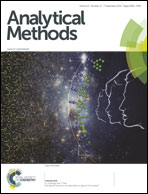Sensitive quantification and visual detection of bacteria using CdSe/ZnS@SiO2 nanoparticles as fluorescent probes†
Abstract
CdSe/ZnS@SiO2–NH2 composite nanoparticles (FNPs) were proposed and used as fluorescent markers for bacteria detection. Salmonella typhimurium acted as representative sample in this paper. It was shown that hydrophobic CdSe/ZnS quantum dots (QDs) were incorporated into SiO2 spheres by using a self-modified reverse-microemulsion technique. FNPs could be successfully covalently conjugated with the bacteria by glutaraldehyde in a two-step strategy. A good linear relationship between the concentration of Salmonella typhimurium and fluorescence intensity was obtained in the range of 6.6 × 102 to 6.6 × 104 cfu mL−1, and the equation was I = 0.1331 log C − 0.2017 with R2 = 0.9974. The detection limit was 3.3 × 102 cfu mL−1, and this method could be applied to other bacteria detection as well. In order to further reduce the detection limit and achieve better visual determination performance, an integrated dielectrophoresis (DEP) microfluidic chip and relative microsystem was established. The FNP-labeled bacteria could be enriched along the edges of interdigitated microelectrodes in the micro-channel by positive DEP and could be counted under the fluorescence microscope.


 Please wait while we load your content...
Please wait while we load your content...